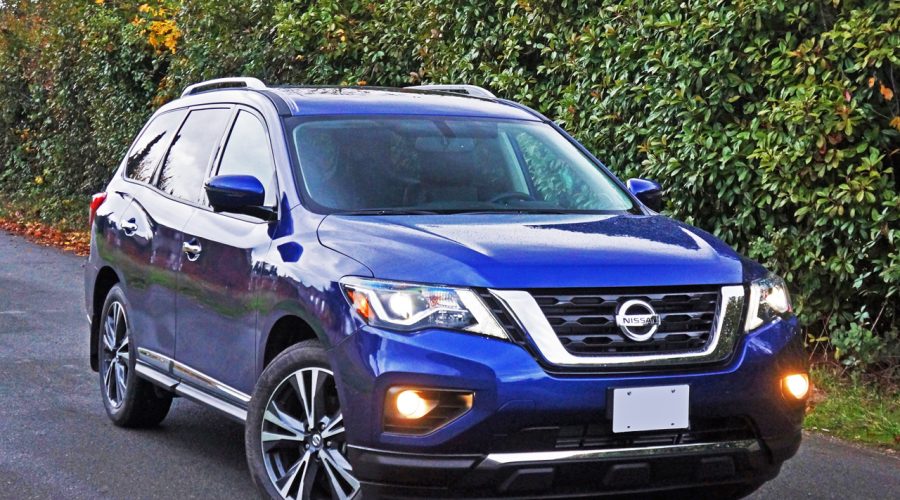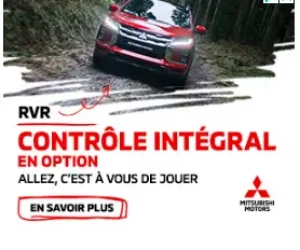There has always been a lot to like about the fourth-generation Pathfinder, unless you’re one of those still lamenting its metamorphosis
 |
| Photo: Karen Tuggay, Canadian Auto Press |
from body-on-frame 4×4 to car-based crossover. Still, even these off-road purists can’t argue against the model’s increased popularity since, as sales numbers don’t lie.
The larger, more refined and altogether more livable mid-size SUV arrived on the scene as a 2013 model in May of 2012, with sales growing from 1,880 units the year before to 2,666 during the changeover year, but it wasn’t until calendar year 2013, the reimagined Pathfinder’s first full year on the market, that it would truly gain traction with 7,936 units delivered, this followed up by 9,688 sales in 2014, 9,898 in 2015, and 9,670 last year. Together with the more recently redesigned five-seat Murano, which just has its best year of 13,834 sales, Nissan’s assault on the mid-size SUV market totaled 23,504 units, which makes it the fourth most popular
 |
| Photo: Karen Tuggay, Canadian Auto Press |
brand in the segment behind Ford, Hyundai, and Toyota, yet passing Dodge last year and still ahead of Kia, Jeep, the combined sales of both GM (Chevy and GMC) models, plus Subaru, Honda, Mazda, and Volkswagen. Not too shabby, Nissan. And now with this 2017 model’s very likable mid-cycle update I believe the Pathfinder’s fortunes will only improve if the overall auto market remains strong.
I can’t say I was a full-on fan of the 2013-2016 version, but only because its styling was a bit soft and generic. Sure it included an early version of Nissan’s now trademark “V-motion” grille that looks strong and distinctive on most of the brand’s renewed models, but pull it up beside this year’s very effective mid-cycle refresh and I’d have no problem choosing between the two. The single word to describe the new look is masculine; its signature chromed grille now fully defined with
 |
| Photo: Karen Tuggay, Canadian Auto Press |
a thick, wide bottom-section that digs further into the more sculpted bumper below, while it’s also positioned more upright and truck-like. Likewise the grille’s matte black insert features more rugged detailing, the headlamp clusters have gone from nondescript to multifaceted and include optional full-LED hardware with LED DRLs, and the lower fascia has received more interesting detail. Despite its blunter more abrupt styling the 2017 Pathfinder actually improves aerodynamics with a new coefficient of drag (Cd) measuring 0.326 compared to 0.34.
New side mirror caps now sport thin LED indicators, while my Platinum trimmed tester boasted new V-shaped twinned 20-inch machine-finished five-spoke alloys with black painted pockets (last year’s Platinum wore great looking 20-inch machine-finished rims too, these just different), while the rear of the SUV reverses
 |
| Photo: Karen Tuggay, Canadian Auto Press |
trends with a set of mostly red-lensed taillights instead of the outgoing version’s arguably more interesting split-clear/red lenses, albeit the new lamps are filled with LEDs that look more sophisticated at night. Additionally, a slightly modified rear bumper gets trimmed with a chromed reverse V (or U?), while other small changes modernize the look. I think most current Pathfinder owners will like the SUV’s return to a bolder, more traditional SUV appearance, styling that Nissan no doubt hopes will win over plenty of new buyers too.
Like with many mid-cycle updates it’s difficult to notice much if any difference between old and new inside the refreshed Pathfinder. The dash top and instrument panel is still made up of large hard plastic panels, which have long been
 |
| Photo: Karen Tuggay, Canadian Auto Press |
below the class average when it comes to perceived quality. Most in the segment, and even the two compact classes below, offer nicer soft-touch elements somewhere within the dash/IP design, especially in top-tier trims, not to mention some even come with fabric-wrapped A-pillars that are also missing from the Pathfinder Platinum, although par for the course this Nissan’s door uppers, inserts, and armrests are nicely finished in softer, padded synthetics, while higher trims even get even plusher leather inserts.
There’s also plenty of satin-finish metallic trim and chrome accents throughout, as well as acres of noticeably faux textured “open-pore” woodgrain, but at least the old-school glossy wood used before is gone. Interior high points include a very attractive electroluminescent gauge cluster featuring a high-resolution, feature-filled
 |
| Photo: Karen Tuggay, Canadian Auto Press |
colour multi-information display at centre, a one-inch larger 8.0-inch infotainment touchscreen with new graphics and features at the top of the centre stack (more on that in a minute), the same albeit still nicely fitted switchgear down that centre stack, on the steering wheel’s spokes and elsewhere around the cabin, highlights of which continue to include knurled metallic rimmed radio and automatic HVAC knobs, all trims getting a standard tri-zone system with yet more switchgear in the rear, plus chromed detailing around the lower console-mounted rotating heatable and cooled seat controls that’s even nicer, whereas the carryover drive mode selector attached to the backside of the gear shifter surround maintains its default Auto, 2WD, (AWD) Lock, and 4×4-i off-road setting for tackling light- to medium-duty trails.
While
 |
| Photo: Karen Tuggay, Canadian Auto Press |
this is no classic truck-based Pathfinder it should perform better off-road than the outgoing model thanks to a new direct-injected 3.5-litre V6 that pushes out 24 additional horsepower and 19 more lb-ft of torque for 284 of the former and 259 of the latter, this partially due to a new mirror bore cylinder coating in place of cast iron liners, and a 11.0:1 compression ratio instead of 10.3:1. The SUV also benefits from 11-percent quicker steering, 11- and 7-percent stiffer front and rear shocks, plus upgraded rebound spring struts with a 25-percent greater rear spring rate, while you’ll be surprised how well modern-day electronic active safety systems, such as ABS, traction control, stability control, hill start assist, hill decent control, etcetera, can help when tackling the wild. Likely the only things wild most Pathfinders will need to contain will be rowdy toddlers and teens, but such was also the case when terrain conquering truck-based SUVs used to rule our
 |
| Photo: Karen Tuggay, Canadian Auto Press |
concrete jungles so car-like unibody SUVs like this Pathfinder continue to make a lot more sense.
Let’s not forget these modernized crossover SUVs tend to be lighter and more fuel-efficient too, the new 2017 model achieving an even better five-cycle EnerGuide result of 11.5 L/100km in the city compared to last year’s 11.9 rating, and its 8.6 L/100km highway estimate is nearly as good as the considerably less powerful SUV’s 8.5 when set up in base FWD trim. Again, despite the performance boost lower end 4WD models get identical 12.1 city and 8.9 highway ratings as the previous fourth-generation Pathfinder, while my as-tested Platinum (heavier due to its extra features) is better in the city at 12.4 L/100km compared to 12.7, and a fraction thirstier on the highway at 9.2 compared to 9.0 L/100km. With most owners racking up the
 |
| Photo: Karen Tuggay, Canadian Auto Press |
majority of their miles in the city it’s a win-win scenario for your pocketbook and the environment.
At the same time that engine gets up and goes much more enthusiastically than the outgoing unit, while the standard continuously variable transmission (CVT) remains wonderfully smooth and similar in feel to a conventional automatic thanks to well-placed artificially stepped gear increments. I like Nissan’s CVT when used in its SUVs more so than its car lineup, because I don’t tend to push large vehicles like this as hard and therefore tend to enjoy the velvety nature of this type of transmission more, Nissan smartly not including paddle shifters with any Pathfinder trim as CVTs work best when left to their
 |
| Photo: Karen Tuggay, Canadian Auto Press |
own devices. The improved engine and previously noted suspension upgrades probably could’ve warranted a little more sport from the transmission, however, its reduced body roll improving road-holding by 0.5 Gs for much more confidence-inspiring handling and therefore greater capability to avoid a potential accident.
Still, as well sorted as the Pathfinder’s improved underpinnings are, this SUV is still mostly focused on comfort. It delivers a very smooth and compliant ride, absorbing the majority of potholes, frost heaves, and bridge expansion joints as if they’re small pavement irregularities, while the big SUV remains an extremely quiet and comfortable conveyance for seven. The large driver seat is eight-way adjustable with two-way powered lumbar support, which just happened to almost perfectly meet the small of my back. The steering column in this Platinum model is
 |
| Photo: Karen Tuggay, Canadian Auto Press |
also powered, while the side mirrors join in for programmable two-way memory settings. Along with the heated and cooled seats mentioned earlier, additional cold-weather comfort comes from a heatable steering wheel, although its controller remains difficult to see and access due to being placed down by the left knee instead of on one of the steering wheel spokes as most others do. The same out of the way panel also houses buttons for the powered liftgate, tow mode, and blindspot alert system.
Up above, an overhead console gets a felt-lined sunglasses holder that continues to use a larger nosepiece holder than any regular-sized pair of sunglasses can straddle, so they flop around within, but the LED reading lights are bright and clear, dome light buttons and SOS telematics panic switch within easy reach, as are
 |
| Photo: Karen Tuggay, Canadian Auto Press |
toggles for the regular sized powered glass sunroof up front. Rear occupants should enjoy the Platinum model’s very large twin-panel fixed glass roof even more, a nice addition that really brightens up the cabin.
In this respect those in back have it better than those up front, but the seats aren’t as comfortable due to short seat squabs and a design that pushes the knees upwards to maximize space in the second row. They’re likely constructed this way to accommodate the Pathfinder’s innovative EZ Flex folding mechanism that not only allows them to collapse and slide forward for easy access to the third row, but do so in a way that lets you keep a regular child safety seat in place while doing so; although remember to remove the child. There’s certainly a lot of room when seated, with about six inches remaining ahead of my knees when the driver’s
 |
| Photo: Karen Tuggay, Canadian Auto Press |
seat was positioned for my five-foot-eight medium-build frame, and another four inches above my head. I’m not even going to approximate side-to-side space as it’s beyond plentiful, so therefore three abreast seating shouldn’t be a problem at all. My tester included heatable rear outboard seats too, plus the aforementioned standard HVAC panel for rear temperature control, which was all good, although the foldable centre armrest with dual cupholders seemed designed for kids as it was too low for me to get comfortable.
The younger set will probably be more transfixed with the Platinum model’s standard dual-screen entertainment system, with individual seven-inch monitors nicely integrated within the backside of each front headrest. They also won’t care that the rear door uppers aren’t finished in soft-touch synthetic like those up front,
 |
| Photo: Karen Tuggay, Canadian Auto Press |
once again unusually subgrade for this class, but at least the armrests and inserts are padded to protect their little elbows and knees.
If you’ve got the middle row set up to maximize legroom there’s not much space in the very back, but fortunately you can slide the former back and forth to provide just the right amount of leg and foot space for both. To be clear I could still fit back there when the middle row was all the way rearward, although my knees were pressed up against the soft seatback, but I was much more comfortable when that middle row was pushed forward a few inches, while I had about three inches above my head no matter the varying legroom, plus excellent side window visibility so I never felt claustrophobic. Each rearmost seat also includes a side vent for air, two cupholders, plus a speaker by the outside shoulder
 |
| Photo: Karen Tuggay, Canadian Auto Press |
position so the quieter moments during movies can still be heard, while an overhead dome light could be used for reading, but a set of LEDs would certainly be more useful.
My tester’s powered liftgate opened up to a very large and accommodating cargo area, as long as the third row was folded. OK, there’s more room behind the third row than some in this class at 453 litres (16.0 cubic feet), or about the size of a mid-size car’s trunk if you pile everything vertically, but lower the 50/50 split rear seatbacks via tugging on the headrest tethers and then flipping up on the release controls and voila, 1,201 litres (42.4 cubic feet) is at your disposal, whereas walking around to the side doors to drop the 60/40-split second-row seatbacks via simple
 |
| Photo: Karen Tuggay, Canadian Auto Press |
levers next to their lower cushions opens up a maximum of 2,260 litres (79.8 cubic feet).
Nice chromed tie-down rings give the cargo compartment an upscale look despite not including carpeted sidewalls, while the rearmost portion of the carpeted cargo floor can be lifted up to expose a fairly deep storage compartment, partially taken up by the Bose subwoofer. Interesting this wasn’t even fixed into place in my tester, but it was easy to screw down thanks to a big fan blade style fastener. This allows you to remove it if you need more cargo space, but I certainly wouldn’t want to hit the road without the 13-speaker Bose audio system’s excellent sound.
That’s just one of many upgrades that come standard with the still reasonably priced
 |
| Photo: Karen Tuggay, Canadian Auto Press |
$48,478 Pathfinder Platinum, some other features not yet mentioned including chrome bodyside mouldings, upgraded NissanConnect infotainment with a 360-degree Around View parking monitor, navigation, mobile apps, voice recognition, and satellite radio, plus forward emergency braking, this latter addition allowing for an IIHS Top Safety Pick rating, whereas all Pathfinder trims are good for 5 Stars from the NHTSA.
Features pulled up from lesser trims, which include the $32,498 base S model, $38,178 SV, and $41,478 SL, include all-wheel drive, auto high beams, fog lamps, roof rails, remote start, proximity-sensing access, pushbutton ignition, variable speed-sensitive intermittent wipers, adaptive cruise control, a universal garage door opener, a leather-wrapped steering wheel, an auto-dimming rearview mirror, auto
 |
| Photo: Karen Tuggay, Canadian Auto Press |
tilt-down side mirrors, rear parking sensors, a four-way powered front passenger seat, perforated leather upholstery, blindspot monitoring with rear cross-traffic alert, a powered liftgate, a trailer hitch receiver and seven-pin wiring harness for the new Pathfinder’s 1,000-lb stronger 6,000-lb tow rating, and much more.
With all its improvements the refreshed 2017 Pathfinder moves from one of my least favourite seven seaters to a model I’d be quick to recommend. It’s now a much more attractive package with a stronger yet mostly more fuel-efficient powertrain, while it retains all of the previous versions best assets. Lastly, it remains one of the better priced mid-size seven-passenger SUVs when comparing features, which all adds up to a competitive advantage over most rivals and a smart choice for consumers.
©(Copyright Canadian Auto Press)







